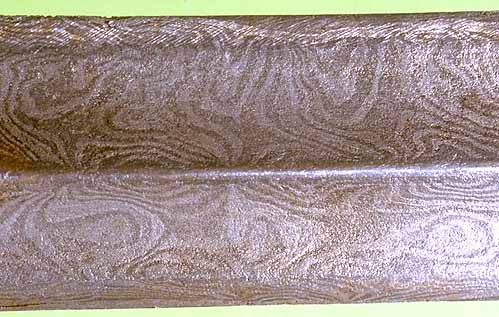

Detail of a Balinese keris blade (20th Century) with a pamor consistent with coarsely laminated contrasting steel alloys. The keris is a type of edged weapon characteristic of the Malay peninsula, Java, and other areas of the South Seas. The above close-up of a keris blade discloses patterns (pamor) upon the surface which also reflect the internal structure of the blade. These swords were made up of a billet composed of alternating layers of steel and of iron containing nickel. In earlier blades, the nickel alloy came from meteoric material while artificial alloys have frequently been used since the 19th Century. In many blades the patterns frequently have the appearance of contour lines such as we might see on a map. The contrasting materials would be welded together in sandwich fashion and the folded back over upon themselves a few (six in the example given by Solyom (1978), p.9 - 10) times to yield a few thousand layers. This is very similar to the fabrication of the Japanese sword, except that the number of layers is smaller in the keris, yielding a bolder pattern. Even when no attempt is made to deliberately and mechanically influence the pattern achieved by deforming the layers, the process of manual forging will result in irregularities of the thickness of particular layers in different parts of the blade. The pattern achieved from the final grinding depends upon how the newly created surface intersects with the layers. In the close-up photograph above, the layers are nearly parallel to the blade face, undulating mildly, so that when ground, wide bands of contrasting metal are seen. Towards the edges, seen best in the lower part of the photograph, as the plane of stock removal cuts across the layers more acutely, the bands become narrower. Many different patterns can be achieved by manipulating the blade before final forging and grinding. Drilling shallow holes into the incomplete blade, then forging the area flat, would result in bull's eye-like structures. Other blades show structures built up by lines engraved into the material before it is again forged flat and then polished, exactly analogous to the kirk narduban of Persian and Indian blades. Keris may also show twisted rod pattern-welding exactly as that seen in European Migration Period and Viking Age blades (discussed subsequently).
<Return to previous part ~ Return to the Table of Contents ^ ~ Go to next part >